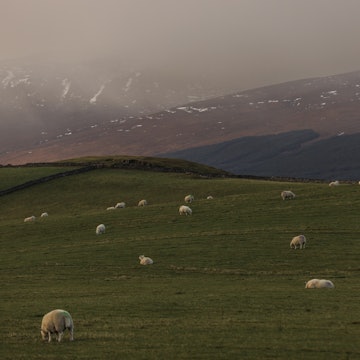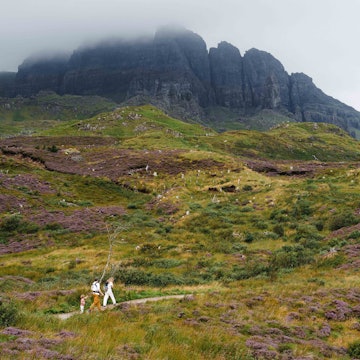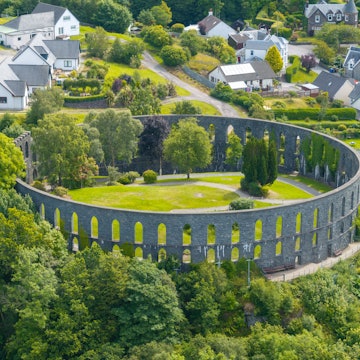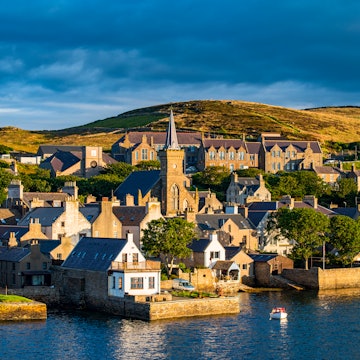

From Sir Walter Scott's former home of Abbotsford to delicious meals and gorgeous landscapes, here's how to explore the Scottish Borders in a weekend. SSDA
The Borders Region of Scotland is typically seen by visitors through the window as they pass on by to more famous Scottish destinations further north: Edinburgh, the Isle of Skye, the Highlands. But the south of Scotland, which includes the Borders Region, is quickly becoming one of my favorite parts of the country.
Steeped in history, the rolling green landscapes and ruined abbeys tell the stories of battles against the English, Roman conquest and royal lineage. The food is a major part of my interest: you’ll find top-class restaurants and cafes across the region, with fresh ingredients and reliable service. And of course there’s the people: friendly, chatty and helpful – I never feel anything but welcome.
When to arrive: I visited the Borders Region midweek, but you can start your itinerary at any time you like. Most places of interest are open 7 days a week, although public transport is more frequent on weekdays, and accommodation is cheaper.
How to get from the airport: Public transportation is definitely the best option for getting to and from Edinburgh airport. There are buses and trams to Edinburgh city center, and from there you can get trains or buses to nearly anywhere in the country. Taxis can take longer due to traffic.
Getting around town: Between trains and buses, there is public transit coverage for the region, but renting a car will give you the most flexibility.
Where to stay: Burt’s Hotel in Melrose – a traditional inn with a good restaurant – is a central option for the Borders Region. The bedrooms are big and comfortable and the lively bar has a great selection of gins. Inglestone House B&B in Kelso is slightly cheaper, and an altogether more homely option, with welcoming, friendly owners and a decent breakfast.
What to pack: Scotland weather is changeable, and, depending on the time of year you visit, wet. Bring waterproofs and hoods, and something that blocks out a chill wind. The Borders is also a great area for walking and hiking, so bring comfortable, sturdy shoes to explore.
Things to know: Every year in the Borders Region there are events called "Common Ridings," which take place on different weeks depending on the town. These ridings stem from the days of common land, when "reavers" – outlaws – would rob the lands, and the locals had to ride the boundaries of the town to keep an eye on things. These commemorative ridings involve hundreds of horses and their riders, and can be quite spectacular – consider planning your trip around one.

Friday
Morning: If you’ve arrived from the airport, you can get the train from Waverley station (in Edinburgh city center) to Galashiels, which is a great spot to begin your exploration of the Borders Region. Galashiels is the second-to-last stop on the way to Tweedbank, on a line which runs every hour. As the train leaves the city, watch as the scenery rolling past your window becomes increasingly pastoral: gentle hills, rivers alongside the tracks, sheep, horses and forest.
Galashiels is a small, picturesque town with lots of greenery and flowers and small cozy coffee shops. Look out for a mural with the black and white houndstooth design that is the emblem of "Gala" (as the locals call it). Grab an exceptional coffee in Bulldog Bakes and visit the Great Tapestry of Scotland, which depicts the history of Scotland.

How to spend the day: Exploring the gorgeous surrounds of Galashiels is the perfect way to spend your first day in the Borders. Pop into Hike & Bike, run by friendly locals Angela and George, who started the organization to help highlight and promote the area. They rent bikes and can take visitors out on cycles and walks, providing lots of local and historical info as you ramble.
Take a moderately strenuous hike to Abbotsford – the former home of Sir Walter Scott – following a trail that goes over the hills by Galashiels, bisecting the Southern Upland Way and along the River Tweed. The house is a must-visit for anyone with even a faint interest in literature. Tour the gorgeous gardens and fascinating museum, complete with an audio tour by Walter Scott himself (well, an actor, but it’s a fun conceit). There’s plenty of interesting ephemera in the house, including an arms room, and items owned by Mary Queen of Scots. My main takeaway was that Scott had a library to be very jealous of.
Dinner: Burt’s Hotel in Melrose is a good option for dinner in the local area. Midrange, with classic gastropub options, I personally recommend the bacon and caramelized onion tart starter, followed by the fish and chips. It's not for the fainthearted though – the massive beer-battered fish comes with chips, tartar sauce and peas with butter. This writer was stuffed enough to forgo dessert, which is saying something.

Saturday
Morning: There are a number of excellent spots in Melrose for breakfast or brunch. Try Apples for Jam or Jack’s for a solid start to the day.
If you’re struggling to decide what to visit or how to organize your time in the Borders, consider the services of Stewart Wilson at Tweed Valley Bloggers. A resident, expert, and longtime blogger of the Borders Region, Stewart offers curated tours and acts as a driving or walking tour guide for groups who want to learn more about the Borders as they explore. Stewart took me on a driving tour around the Borders Region, and we started our day at the Trimontium Museum.
A major draw of Melrose lies in its history: it was the site of one of the northernmost Roman settlements, built in 79CE. Before visiting the site itself – which is a field in Newstead just outside Melrose – stop at the Trimontium Museum, which is the best way to explore the local history. With an excellent VR of the old Roman frontier fort alongside a fantastic small museum, you are immersed in the life of the settlement – including the northernmost amphitheater of the Roman Empire – and its downfall: it was eventually abandoned by the Romans who retreated behind Hadrian’s Wall.

How to spend the day: You could do worse with your day than head to St Boswell’s and have lunch at the Main Street Trading Company (I recommend the ploughman’s). It’s a great spot, with a delightful and tempting bookshop. In the vicinity there are also some gorgeous areas to explore, including Leaderfoot Railway Viaduct, Scott’s viewpoint, and the ruins of Dryburgh Abbey where Walter Scott is buried.
A particularly interesting site in the area is the 6m (20ft) statue of William Wallace. Commissioned and built by David Erskine, the 11th Earl of Buchan, who also funded the maintenance of Dryburgh Abbey, the statue is an intriguing oddity: the kilt is wrong, the German helmet he has on (for some reason) is wrong, the claymore is wrong. At over 200 years old, with a vantage point over the whole region, it was built more out of the myth and legend of Wallace than historical knowledge.
Dinner: Kelso – another picturesque and pleasant town with a big ruined abbey bang in the middle – has Georgian buildings, expensive shops and cobblestoned streets. Consider the Contented Vine for an upscale meal. With low lighting, high ceilings and attentive staff, it’s comfortable if slightly staid. The scallops were like butter, served with crispy bacon, pea puree and black pudding, and full of flavor. The carbonara was rich, creamy, cheesy, garlicky and delicious. And the dessert of sticky toffee pudding (despite being so full, I could not resist!) was rich, buttery and delightful.
After dark: And if you fancy a pint in the evening, find your way to the Cobbles pub that serves local craft beers from the Tempest Brewing Co (try the Lazy Armadillo session IPA). There’s an open fire, the smells of which pervade the bar, and it’s golden-warm and cozy.

Sunday
Morning: Dedicate the morning to exploring Jedburgh. Home to yet another impressive abbey, and steeped in history, there’s plenty to keep you busy. Consider breakfast in Simply Scottish or Naomi’s Kitchen. Start at Jedburgh Jail, at the top of the hill, which gives an interesting insight into the history of the region and how the residents looked at the world. There are tidbits about the prisoners (some as young as 8 years old) and some uncanny figurines. It was at Jedburgh Jail that I learned about the horrifying mort safes – heavy iron boxes placed over coffins to deter body-snatchers.
How to spend the day: Thirlestane Castle in Lauder is one of the grand old houses of the region that allows visitors and is interesting for its insight into how the wealthy lived, and still live to this day. A ramble around the house makes for an engaging afternoon, with its four-poster beds, ornate plaster ceilings, portraits and photos. Tours of the house are given by enthusiastic volunteers, and the property is now rented out for events, weddings and shooting parties. Stop off at Brew on the way for an excellent coffee. For something a bit more substantial, head to Flat Cat Gallery in Lauder town for lunch.
The next time I return to the Borders Region I will time my visit to coincide with one of the Common Ridings, and embed myself further into these history-steeped hills.
Amy Lynch traveled to Scotland at the invitation of the South of Scotland Destination Alliance (SSDA). Lonely Planet staff members do not accept freebies in exchange for positive coverage.
















